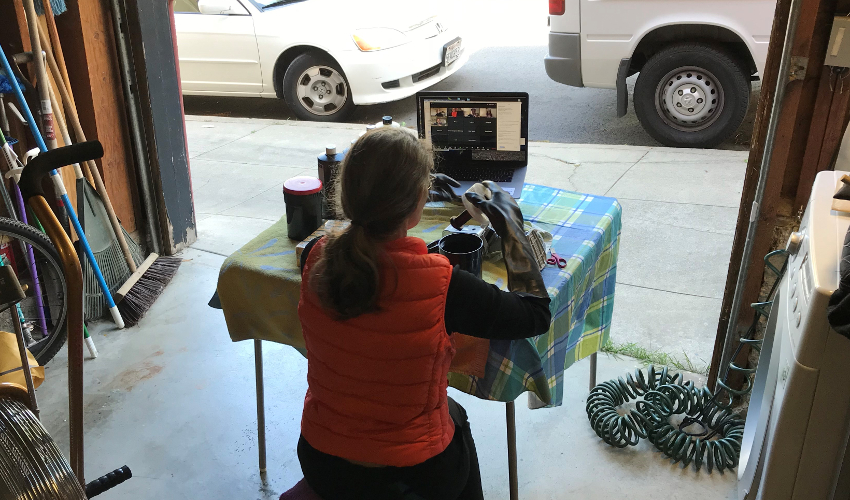SF State faculty members rise to the shelter-in-place challenge with remote instruction

Professor of Cinema Greta Snider demonstrates a film processing technique in her garage for her “Material Cinema” course.
With COVID-19 moving classes off campus, instructors find creative ways to give students a top-notch education
How do you teach a weightlifting class with no weights? If you’re Lecturer of Kinesiology John Penacerrada, the answer is simple: You improvise.
“I’ve been telling students that if you don’t have dumbbells or kettlebells or whatnot, get your backpack and fill it with some books,” said Penacerrada. “It’s about being resourceful and still getting a good workout out of what we can do.”
Penacerrada is just one of hundreds of San Francisco State University faculty members who are now teaching students remotely due to the COVID-19 pandemic. Between adapting exercise routines, improvising laboratory experiments and connecting with students through forward-thinking technology, instructors across the University are doing what they do best: delivering a comprehensive and engaging education.
When the city of San Francisco announced a shelter-in-place order, Penacerrada was faced with the especially formidable task of teaching fitness classes that usually happen in rooms full of specialized workout equipment like barbells and squat racks. Along with his backpack solution, Penacerrada drew on his 20 years of industry experience to quickly develop and record new workout routines that use improvised equipment or simply take advantage of the body weight of the exerciser (like push-ups). Students watch tutorial videos and submit highlight reels of their own exercises so he can quickly assess them and provide guidance.
Penacerrada also raced to modify “Intro to Sports and Fitness Management” because the internships students usually take as part of the course were canceled. If students couldn’t experience the industry in person, Penacerrada decided, he would bring the industry to them. His class has hosted Zoom lectures from a wide range of professionals — a physical therapist, a chiropractor, a coach and more — many of them San Francisco State alumni. “I wanted them to see different sides of how you can actually succeed with a kinesiology background,” he explained.
Science laboratory courses, which rely on high-tech equipment and spaces, are similarly hard to squeeze into a Zoom-sized window. In Professor of Biology Katharyn Boyer’s “Wetland Ecology” course, students designed and started an experiment using plants raised in the greenhouse at SF State’s Estuary and Ocean Science Center. Rather than cutting the experiment short, Boyer transferred the experiment piece by piece to the deck of her own home, placed under a translucent table that protects the plants from the elements while letting in sunlight. Though it wasn’t easy, Boyer says it was important that students be able to see the experiment through to its conclusion. “I feel this is a critical experience for our students to understand the process of science,” she explained.
Over weeks of sheltering in place, Boyer’s students continued their research determining which environmental conditions help the federally endangered California sea-blite plant grow the best. They’re now analyzing and writing about their results.
“This is original research, addressing questions that will help in the management and conservation of wetland habitats,” Boyer said. “We don’t know the answers to these questions. It’s not like we could have found an online version of this from another source.”
Although everyone has had to adapt to remote instruction, Assistant Professor of Civil Engineering Zhaoshuo Jiang was about as prepared as anyone could be. A longtime proponent of remote teaching techniques, Jiang earned a CSU faculty innovator award for his creative use of technology in the classroom.
Jiang acknowledges that remote learning comes with challenges and limitations, but also says that it gives students more opportunities to participate in their classes. “Before classes went online, I was hosting virtual office hours to promote interactions with students and provide access to those Q&A sessions from anywhere, anytime,” Jiang explained. Holding these virtual office hours means that students with long commutes or busy work schedules have the same chance to engage and learn as their peers.
Now, Jiang also livestreams and records lectures while writing notes and diagrams with a smart pen, color-coding examples and streaming them along with his lecture.
“The internet is good for some things, but not all things,” Snider explained. “The U.S. Mail has been incredibly important to our class.”
When students complete their experimentation at home, they mail the film back to Snider so she can digitize the film for editing. She’s embraced technology in other ways, though: Her classes have hosted demonstrations by visiting artists over Zoom, with some future appearances planned with speakers in locations as far away as Japan.
And as she adapts her course material, Snider has also tried recreating some of the social aspects of taking a class in person — all the more important at a time when many may feel isolated. She opens her Zoom classroom early to allow students opportunities to chat before she joins the class and holds regular check-ins where students can talk about their lives.
“People seem to enjoy it, and I hope it’s making a difference,” Snider said. “You might not go out for a sandwich with folks in your class, but you have developed this other relationship — and that’s really important.”


